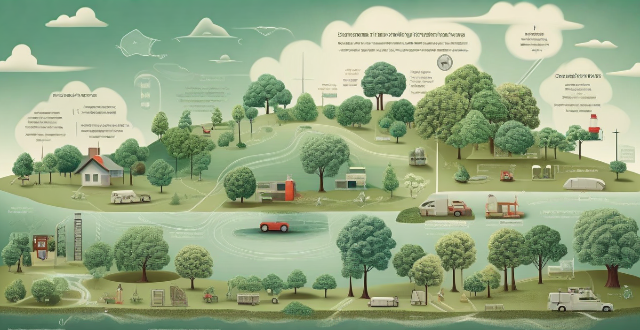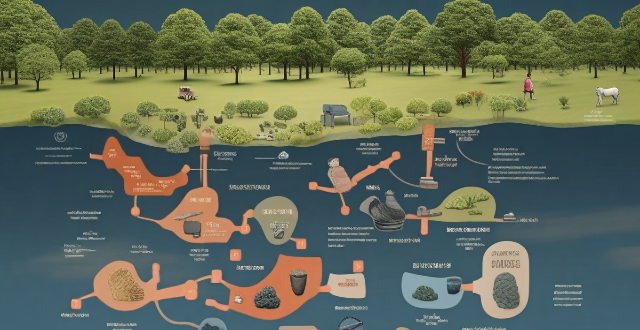Climate Loss

What are the long-term consequences of climate loss and damage ?
The article discusses the long-term consequences of climate loss and damage, including rising sea levels, extreme weather events, loss of biodiversity, impact on agriculture, disruption of industries, costs of mitigation and adaptation, health risks, displacement and migration, and impact on culture and heritage. It highlights the need for a global effort to reduce greenhouse gas emissions and adapt to the changing climate in order to create a more sustainable future.

How do climate change and biodiversity loss intersect ?
Climate change and biodiversity loss are interconnected issues that impact each other significantly. Climate change can lead to habitat loss, altered migration patterns, and changes in prey-predator relationships, all of which can result in reduced populations or even extinction for some species. On the other hand, biodiversity loss can reduce carbon sequestration, compromise soil health and water regulation, and impair ecosystem services that help mitigate climate change. Urgent action is needed from all stakeholders to address these challenges and protect our planet's fragile ecosystems.

How can we measure the extent of climate loss and damage ?
Measuring the extent of climate loss and damage requires a comprehensive approach that considers various factors, including direct and indirect impacts on natural and human systems. To measure these impacts, we need to identify affected areas, quantify economic losses, assess social and health impacts, evaluate environmental impacts, and consider long-term implications. By doing so, we can better understand the scope of climate loss and damage and develop effective strategies for adaptation and mitigation.

How does climate loss and damage affect vulnerable communities ?
The text discusses the impact of climate loss and damage on vulnerable communities. It highlights that these impacts are multifaceted and can be categorized into various sectors including health, agriculture, infrastructure, and social stability. The health impact includes direct and indirect risks from extreme weather events and disruptions to food and water security. The agricultural impact involves crop failures due to changes in precipitation and temperature patterns, leading to loss of livelihoods and increased food prices. Soil degradation also reduces land productivity. Infrastructure damage includes coastal erosion and inland flooding, causing property loss, disruption of services, and repair costs. Social stability is affected by displacement due to environmental changes and economic strain from adapting to climate change. The conclusion emphasizes that addressing these challenges requires global cooperation and targeted support to build resilience and protect those most at risk.

What are the ethical implications of climate loss and damage ?
The ethical implications of climate loss and damage are multifaceted, involving issues of justice, responsibility, human rights, and intergenerational equity. Those who have contributed the least to climate change are often disproportionately affected by its consequences, raising questions about fairness and justice. Responsibility and accountability for addressing these impacts are also crucial, with industrialized nations having historically emitted more greenhouse gases and generally having more resources to invest in climate action than poorer ones. Climate loss and damage pose serious threats to human rights, including the right to life, health, food, water, and housing. Intergenerational equity is also a significant consideration, as current generations must not deprive future generations of the ability to meet their own needs by depleting natural resources and altering the climate system. Addressing these challenges requires global cooperation and a commitment to creating a more equitable and sustainable world for all current and future inhabitants of our planet.

What is the relationship between climate loss and damage and food security ?
The article discusses the complex relationship between climate loss and damage and food security, highlighting how extreme weather events and slower changes in climate can impact food production. It details the consequences of these impacts for food security, such as reduced crop yields, increased prices, loss of livelihoods, nutritional impacts, and displacement. The article also suggests mitigation and adaptation strategies to address this issue, including reducing greenhouse gas emissions, sustainable agriculture practices, crop diversification, improved irrigation systems, early warning systems, and research and development. The conclusion emphasizes the need for collective action to ensure food security in the face of climate change.

What is the relationship between climate change and loss of habitat for endangered species ?
Climate change is causing significant changes in ecosystems around the world, leading to the loss of habitat for endangered species. Rising temperatures, changing precipitation patterns, sea level rise, and extreme weather events are all factors that contribute to this loss. Endangered species are particularly vulnerable to these changes due to their small populations and limited ranges. Examples of endangered species affected by climate change include polar bears, giant pandas, leatherback turtles, and amphibians. It is essential that we take action to protect these species and their habitats, including reducing greenhouse gas emissions, conserving natural habitats, and developing adaptation strategies.

What is climate loss and damage ?
Climate loss and damage refer to the negative impacts of climate change on natural and human systems, including direct impacts such as extreme weather events and sea-level rise, and indirect impacts such as ecosystem changes and food security issues. Mitigating these impacts involves reducing greenhouse gas emissions and adapting to the inevitable effects of climate change.

How does deforestation contribute to both climate change and biodiversity loss ?
The text discusses the impact of deforestation on climate change and biodiversity loss. It explains how trees act as carbon sinks, absorbing CO2 from the atmosphere during photosynthesis, but when forests are cleared, this process is halted, and the stored carbon is released back into the atmosphere as CO2. Deforestation also involves burning trees, which releases other greenhouse gases like methane and nitrous oxide, contributing to global warming. The text further explains how forests provide habitat for countless species of animals, insects, and plants, but clearing forests destroys these habitats, leading to a loss of biodiversity. Even partial deforestation can fragment habitats, isolating populations and reducing genetic diversity. Without tree roots to hold soil together, erosion increases, affecting water quality and availability, which can further impact species that depend on specific water sources or soil types. The text concludes that deforestation is a complex issue with far-reaching consequences for both climate change and biodiversity loss, requiring a multifaceted approach that considers both environmental protection and human needs.

Can we prevent climate loss and damage ?
This topic summary discusses the challenges and potential solutions to preventing climate loss and damage, which are negative impacts of climate change on natural and human systems. It highlights the scientific consensus on climate change, irreversible changes already underway, and differential impacts on various regions and communities. The summary then explores mitigation efforts such as reducing greenhouse gas emissions through energy transition, efficiency improvements, and forestry management, as well as carbon capture and storage technology. It also discusses adaptation strategies like building resilience through infrastructure updates, agricultural practices, coastal protection, community-based adaptation, local knowledge, and capacity building. International cooperation is emphasized through global agreements, financial support, and technology transfer. Lastly, individual actions such as lifestyle changes, advocacy, education, and awareness are mentioned as crucial components in minimizing further damage caused by climate change.

How does climate vulnerability affect the environment ?
Climate vulnerability refers to the degree to which a system is susceptible to, and unable to cope with, adverse effects of climate change. This vulnerability can have profound impacts on the environment, affecting ecosystems, biodiversity, and the services they provide to humans. Key points include changes in ecosystems, loss of biodiversity, impacts on water resources, food security, and coastal systems. These changes can lead to altered migration patterns, changes in vegetation, disruption of life cycles, habitat loss, extreme weather events, invasive species, changes in snowmelt patterns, rainfall changes, shifting climate zones, pest and disease outbreaks, sea level rise, and ocean acidification. Addressing climate change is essential for the survival of countless species and the well-being of human societies that depend on the services provided by healthy ecosystems.

What are the impacts of climate vulnerability on human societies ?
The impacts of climate vulnerability on human societies are multifaceted and can be categorized into various sectors including health, economy, environment, and social structures. The health impacts include an increase in heat-related illnesses and the spread of diseases. The economic impacts involve loss of livelihoods and increased costs. The environmental impacts consist of biodiversity loss and water scarcity. The social impacts include displacement and migration, as well as food insecurity. Addressing these challenges requires coordinated efforts at local, national, and international levels to mitigate greenhouse gas emissions and adapt to the inevitable changes brought about by climate change.

What are the implications of not meeting climate targets ?
The article discusses the implications of not meeting climate targets, including rising sea levels leading to coastal erosion and loss of habitat; extreme weather events causing heatwaves and storms; biodiversity loss resulting in species extinction; economic disruption due to disaster recovery costs and loss of productivity; health impacts such as heat-related illnesses and air quality issues; food security concerns from reduced crop yields and water scarcity; and displacement and migration caused by climate change. It emphasizes the importance of meeting climate targets to mitigate these adverse effects on the environment, economy, and society.

What role do governments play in addressing climate loss and damage ?
Governments play a critical role in addressing climate loss and damage through legislation and policy making, research and development, education and awareness, and international cooperation. They can enact laws that regulate emissions and protect natural resources, develop policies that encourage sustainable practices, fund research into new technologies for reducing greenhouse gas emissions, launch public education campaigns to raise awareness about climate change, and work together through international agreements and collaborative projects to share knowledge and resources. By taking these actions, governments can help mitigate the effects of climate change and protect our planet for future generations.

What is the Paris Agreement and its impact on climate governance ?
The Paris Agreement, adopted in 2015, aims to limit global warming and represents a unified effort by countries worldwide to address climate change. Key features include long-term goals, nationally determined contributions (NDCs), adaptation measures, loss and damage mechanisms, financial support, and transparency frameworks. The agreement has impacted climate governance by promoting global cooperation, enhancing political commitment, providing flexibility in NDCs, establishing financial mechanisms, ensuring transparency, recognizing loss and damage, integrating policies, involving the private sector, and raising public awareness. Despite implementation challenges, the Paris Agreement has set the stage for concerted action on climate change.

What is the relationship between climate change, environmental degradation, and population movements ?
The text discusses the interconnectedness of climate change, environmental degradation, and population movements. It explains how these factors influence each other and their potential impacts on society and the environment. Climate change directly affects the environment through rising sea levels, extreme weather events, and habitat loss. Environmental degradation contributes to climate change through deforestation and soil erosion. Population movements are influenced by climate change through displacement, resource scarcity, and health risks, while environmental degradation leads to loss of livelihoods, pollution, and habitat loss. The relationship between these issues is complex and requires integrated approaches to conservation and sustainability efforts.

How does climate change affect the rights of marginalized communities ?
Climate change disproportionately affects marginalized communities, impacting their rights in several ways: loss of territory and habitat, degradation of natural resources, increased disease risk, limited access to healthcare, loss of livelihoods, inequality in adaptation and mitigation efforts, loss of cultural heritage, and displacement and migration. Addressing these challenges requires global action that prioritizes the needs and rights of vulnerable groups.

Can organic food help with weight loss ?
Organic food may aid weight loss by reducing exposure to harmful chemicals, offering higher nutrient content, having lower calorie density, and improving digestion. Incorporating organic options slowly, choosing locally grown produce, reading labels carefully, planning meals, and including protein sources can support a healthy eating plan conducive to weight loss.

Can fitness trackers help me achieve my weight loss goals ?
Fitness trackers can support weight loss by tracking steps, heart rate, sleep, and calories. They provide motivation, accountability, and data for decision making. However, they have limitations such as overreliance on technology and accuracy concerns. It's important to use them wisely and in conjunction with other healthy habits for effective weight loss.

How does climate change affect the environment ?
The article discusses the various impacts of climate change on the environment, including rising temperatures leading to melting glaciers and ice sheets, changes in precipitation patterns causing droughts and extreme rainfall events, and extreme weather events such as heat waves and hurricanes. It also highlights the loss and fragmentation of habitats due to range shifts and coral reef bleaching, as well as the loss of biodiversity through direct effects like species extinction and population declines, and indirect effects like food web disruptions and disease spread. The article emphasizes the need for urgent action to reduce greenhouse gas emissions and implement adaptation strategies to mitigate these impacts on our planet's ecosystems.

Can strength training help with weight loss ?
Strength training, involving the use of resistance to induce muscular contraction and build strength, can significantly contribute to weight loss by increasing metabolic rate, boosting post-exercise oxygen consumption (EPOC), improving body composition, and enhancing appetite control. Incorporating strength training into your routine, starting slowly and focusing on compound movements while staying consistent, can help achieve weight loss goals.

What are the economic impacts of climate loss and damage ?
The article discusses the economic impacts of climate loss and damage, including direct impacts on agriculture, coastal communities, and health, as well as indirect impacts on the energy sector, insurance and financial services, and the labor market. It highlights the need for a comprehensive approach to address these challenges.

Can yoga help with weight loss ?
Yoga can be a valuable addition to a weight loss program due to its ability to improve muscle tone, increase flexibility, reduce stress levels, and promote mindful eating habits. Incorporating yoga into your routine along with other forms of exercise and healthy lifestyle habits can help you achieve your weight loss goals and improve overall health and well-being.